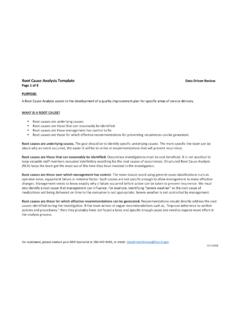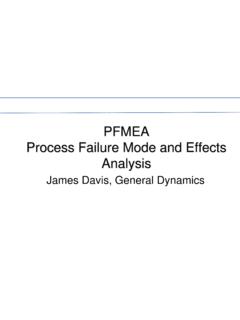Transcription of Root Cause Analysis - CIOB Academy
1 root Cause Analysis ACCIDENT AND INCIDENT. root Cause Analysis . "On the occasion of every accident that befalls you, remember to turn to yourself and inquire what power you have to turn it to use.". - Epictetus d. 135 AD. Terry ap Hywel 2018 1. root Cause Analysis Table of Contents COURSE AIMS & OBJECTIVES .. 3. ACCIDENTS and 4. Basic Accident or Incident Causation.. 5. Accident Prevention .. 6. ACCIDENT INVESTIGATION .. 8. Guidelines for Investigating Accidents .. 10. Recommending effective control measures .. 10. HUMAN FACTORS IN ACCIDENTS .. 15. What are Human Factors? .. 15. Human Failure .. 15. INFLUENCES ON BEHAVIOUR .. 17. The Organisation .. 17. The 18. The 19. ADVANCED TECHNIQUES .. 21. Sequence of 21. Critical Events .. 22. root 24. MORT Analysis .. 25. Technic (Technique) of Operations Review (TOR) .. 27. TOR 30. Terry ap Hywel 2018 2.
2 root Cause Analysis COURSE AIMS & OBJECTIVES. Aims: At the end of this course candidates should be able to: - Investigate events which led, or might have led to an injury;. - Use techniques to identify the root causes of accidents and incidents - Prepare formal reports and make logical and cost effective proposals to prevent a repetition. Objectives: Candidates will have a knowledge and understanding of: Accident Prevention and Investigation The principles of accident prevention and the root causes of accidents. The procedures for investigating accidents to identify the root Cause . Different root Cause Analysis techniques. Course Content Recap Basic Accident Causation and Investigation Human Factors in accident causation Human failure Active and Latent failures Errors and violations Job, individual and organisational factors affecting human reliability.
3 Advanced techniques for gathering information Principles of sequence diagrams Event and causal factor Analysis Multilinear Events Sequencing, etc. Critical event identification Fault tree, barrier and change Analysis Advanced techniques for root Cause identification Tree techniques . MORT, etc. Checklist techniques TOR, etc. Syndicates exercises to explore the above throughout the day. Course Review. Terry ap Hywel 2018 3. root Cause Analysis ACCIDENTS AND INCIDENTS. Health and safety management is about the prevention of accidents and ill health, but what is an accident? Accident - The most common definition is:- An unplanned, undesired occurrence which results in loss of any kind. Incidents The above definition of an accident does not include those events that could have caused loss. Such events are often called incidents, near misses, close calls or near hits.
4 Whatever term we use it is purely chance that prevents an incident from becoming an accident. The severity of injuries or damage resulting from an accident is also often a matter of chance. There have been many studies carried out to try to establish a relationship between accidents and incidents. These are illustrated by accident triangles or accident icebergs. 1 Fatal / Serious Injury 3 Minor Injury 50 Property Damage 600. Near Miss /. Incident Frank Frank Bird Terry ap Hywel 2018 4. root Cause Analysis BASIC ACCIDENT OR INCIDENT CAUSATION. There are always valuable lessons to be learned by investigating accidents, but our legislation requires employers to be pro-active to identify hazards and to ensure they are adequately controlled. Any hazard not adequately controlled is an accident waiting to happen . Hazard - Something with the potential to Cause harm.
5 Examples of hazards:- Physical: Moving parts of machinery, electricity, heat, noise, gravity Chemical: Carbon monoxide, sulphuric acid, asbestos, Biological: HIV virus, legionella, Hepatitis virus Psychological: Stress, shock, anxiety Uncontrolled or poorly controlled hazards create unsafe acts and/or unsafe conditions and are almost always the result of underlying or organisational failures Unsafe Conditions such as trailing cables, oil spills on floors, missing guards, unsecured ladders etc. are usually easy to spot during an inspection. Unsafe Acts such as carrying passengers on a fork lift truck, grinding without goggles or climbing storage racks are more difficult to find during occasional inspections. Many unsafe conditions are caused by unsafe acts therefore it is important to try to trace each unsafe condition back to its source. Unsafe acts and unsafe conditions are almost always the result of underlying failures.
6 Lack of proper information or training, unsafe systems of work, poorly maintained or unsuitable equipment, poor planning, unclear responsibilities, poor supervision. And these underlying failures are the symptoms of failure of management control which is the root Cause of the majority of accidents. root Cause There are many definitions but a most useful one is that used by Paradies and Busch (1988), that is: The most basic Cause that can be reasonably identified and that management has control to fix Terry ap Hywel 2018 5. root Cause Analysis Domino Theory The Domino Theory of accident causation dates back to Heinrich in the 1930's. The theory has been developed over time by various writers and there are a few versions but the most widely accepted version is shown here. A B C D E. A = Lack of Management Control B = Underlying causes C = Unsafe Conditions and/or Acts D = Accidents E = Injury, damage or other loss The Injury domino is at the end of a line of dominoes and is the last to fall.
7 The principle behind the theory is that the further back up the line of dominoes you concentrate your attention, the better the results. If you only react to accidents you will not deal with the unsafe conditions which Cause them, by looking carefully at management control you can eliminate or reduce the underlying reasons that lead to unsafe conditions and acts. ACCIDENT PREVENTION. Accident investigation is therefore considered to be a reactive approach, it is unlikely to get to the root Cause unless it is carried out very thoroughly. A proactive approach is to pay proper attention to management control by means of: setting clear policies, plans, aims and objectives clearly defined responsibilities well thought out procedures competent staff standards of performance measurement of performance. The aim is to eliminate or reduce the opportunities for hazards to exist.
8 Terry ap Hywel 2018 6. root Cause Analysis It can be seen that these are the fundamental principles of managing anything, not just health and safety. The principles of accident prevention are therefore a matter of being in control of what goes on and directing activities toward the desired outcome whilst minimising the risk of undesired outcomes - it is called MANAGING. Terry ap Hywel 2018 7. root Cause Analysis ACCIDENT INVESTIGATION. "I keep six honest serving men. They taught me all I knew. Their names are What and Why and When and How and Where and Who.". - Rudyard Kipling There are a number of good reasons for investigating accidents To identify and eliminate the causes There is a statutory duty to report certain injuries, the report must include an account of the accident. (RIDDOR). To defend civil claims for compensation Employees Liability insurers require it To demonstrate concern about people's safety.
9 It is unwise to depend only upon accident investigations as a means of preventing accidents, nevertheless a lot can be learned from the thorough investigation of accidents. Any accident, or incident, is clear evidence of lack of control something has happened that should not have! Too often accident investigations fail to identify root causes because they:- only identify the Cause of the injury, not the Cause of the accident focus on the people or equipment that were at fault, ignoring the organisational controls that should have prevented them from being at fault look for a single Cause when there may be several direct causes each of which resulted from some failure in the system of managing. Multi Cause Theory Accidents are often the result of the chance convergence of several indirect causes , each of which may result from several factors which need to be addressed.
10 Example Late for an appointment, Mr Smith slips on a patch of oil. The accident report from would typically be completed as follows: "Oil cleaned up with granules, Mr Smith should take more care in future.". A more thorough investigation might identify the source of the oil spillage as being a poorly maintained fork lift truck, subsequent inquiries might identify precisely what is wrong with the Terry ap Hywel 2018 8. root Cause Analysis maintenance procedures. If Mr Smith was not taking proper care, why not? How can we ensure that he does so in future? Why was the oil spillage not dealt with earlier, who is responsible for the area what are the procedures and standards, are they adequate? etc. etc. The time and trouble taken to investigate an accident will depend upon the seriousness of the actual or potential damage or injury. However, every accident and near missshould be investigated and recorded.







